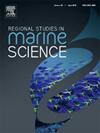HAMSCNN:用于海上监视中精确船舶检测的混合关注多尺度CNN
IF 2.4
4区 环境科学与生态学
Q3 ECOLOGY
引用次数: 0
摘要
海上监视是全球安全、贸易监测和环境保护的重要组成部分,船舶探测在防止非法活动和确保航行安全方面发挥着关键作用。卫星图像与深度学习技术相结合,已成为实时船舶检测的强大解决方案,与传统方法相比,具有更高的准确性和可扩展性。在本研究中,提出了一种新的深度学习模型——混合注意多尺度CNN (HAMSCNN),将卫星图像准确地分为有舰和无舰两类。该模型集成了航道注意、空间注意和多尺度卷积块,以增强特征提取,强调关键的空间和航道信息,并改善不同船舶尺寸和海洋条件下的检测。该数据集包括4000张卫星图像,其中有1000张船图像和3000张无船图像,通过翻转、缩放和旋转等数据增强技术解决了类别不平衡的挑战。HAMSCNN模型结合了批归一化、退出层和最大池化,以提高正则化和稳定性。大量的实验表明,所提出的模型显著优于现有的最先进的架构,实现了99 %的分类准确率,精度,召回率和f1分数都达到0.99。混淆矩阵突出了模型的可靠性,最小的错误分类(6个假阳性和4个假阴性),加强了它对现实世界部署的适用性。研究结果强调了HAMSCNN在推进自主船舶探测方面的潜力,为海上监测提供了高效、经济、可扩展的解决方案。未来的工作将探索合成孔径雷达(SAR)数据的集成,以增强恶劣天气条件下的鲁棒性,并扩大模型对多类别海上目标检测的适用性。本文章由计算机程序翻译,如有差异,请以英文原文为准。
HAMSCNN: A hybrid attention multi-scale CNN for accurate ship detection in maritime surveillance
Maritime surveillance is a critical component of global security, trade monitoring, and environmental protection, with ship detection playing a key role in preventing illegal activities and ensuring safe navigation. Satellite imagery, combined with deep learning techniques, has emerged as a powerful solution for real-time ship detection, offering enhanced accuracy and scalability over traditional methods. For the study, a novel deep learning model, Hybrid Attention Multi-Scale CNN (HAMSCNN), is proposed to accurately classify satellite images into Ship and No-Ship categories. The model integrates channel attention, spatial attention, and multi-scale convolution blocks to enhance feature extraction, emphasize critical spatial and channel-wise information, and improve detection across varying ship sizes and oceanic conditions. The dataset comprises 4000 satellite images, with 1000 Ship images and 3000 No-Ship images, addressing the challenge of class imbalance through data augmentation techniques such as flipping, zooming, and rotation. The HAMSCNN model incorporates batch normalization, dropout layers, and max-pooling for improved regularization and stability. Extensive experiments demonstrate that the proposed model significantly outperforms existing state-of-the-art architectures, achieving a classification accuracy of 99 %, with precision, recall, and F1-scores all reaching 0.99. The confusion matrix highlights the model’s reliability, with minimal misclassifications (6 false positives and 4 false negatives), reinforcing its suitability for real-world deployment. The results underscore the potential of HAMSCNN in advancing autonomous ship detection, enabling efficient, cost-effective, and scalable solutions for maritime monitoring. Future work will explore the integration of Synthetic Aperture Radar (SAR) data to enhance robustness under adverse weather conditions and expand the model’s applicability to multi-class maritime object detection.
求助全文
通过发布文献求助,成功后即可免费获取论文全文。
去求助
来源期刊

Regional Studies in Marine Science
Agricultural and Biological Sciences-Ecology, Evolution, Behavior and Systematics
CiteScore
3.90
自引率
4.80%
发文量
336
审稿时长
69 days
期刊介绍:
REGIONAL STUDIES IN MARINE SCIENCE will publish scientifically sound papers on regional aspects of maritime and marine resources in estuaries, coastal zones, continental shelf, the seas and oceans.
 求助内容:
求助内容: 应助结果提醒方式:
应助结果提醒方式:


